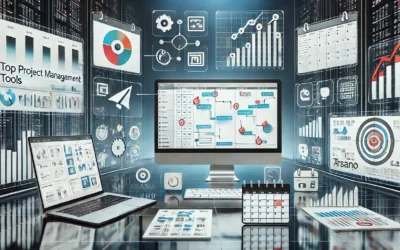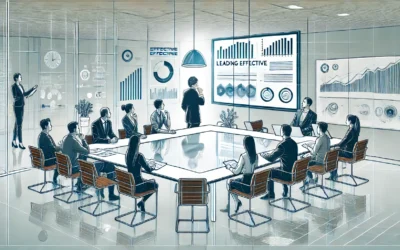The Roadmap to Project Success
Imagine embarking on a grand adventure, where each step brings you closer to achieving something remarkable. That’s exactly what managing a project from start to finish feels like! The project life cycle is the series of phases that a project passes through, guiding it from a mere idea to a tangible reality. Whether you’re a seasoned project manager or just dipping your toes into the world of project management, understanding these phases is crucial for delivering successful projects.
In this comprehensive guide, we’ll explore the five key phases of the project life cycle and how they work together to create a framework for project success. By mastering these phases, you’ll be better equipped to guide your projects from conception to completion with confidence and clarity.
The 5 Phases of Project Management
The Project Management Institute (PMI) outlines five distinct phases in the project management life cycle. Each phase plays a vital role in the project’s journey, with specific activities, deliverables, and goals. Let’s dive into each phase and discover how they contribute to keeping your project on track and moving forward.
1. Initiation: Setting the Foundation
The project initiation phase is where your project begins to take shape. This crucial first step helps determine whether the project is feasible and aligns with organisational goals. Think of it as laying the cornerstone of a building—everything else will depend on getting this right.
Key Activities in the Initiation Phase:
- Developing the project charter: This document formally authorises the project and outlines its objectives, scope, and stakeholders.
- Identifying key project stakeholders: Determine who will be involved in or affected by the project.
- Conducting a feasibility study: Assess whether the project is viable and worth pursuing.
- Defining project goals and deliverables: Clarify what the project aims to achieve and what it will produce.
- Securing initial resources and approval: Obtain the necessary authorisation and resources to move forward.
During initiation, you’ll answer fundamental questions like:
- What problem are we solving?
- Who will benefit from this project?
- What are the project’s objectives and expected outcomes?
- Is this project aligned with our organisation’s strategic goals?
- Do we have the capability and resources to deliver it successfully?
“A well-executed initiation phase can make the difference between project success and failure,” explains Ryan from Project Success Hub. “It’s where you build the foundation that will support every subsequent phase.”
2. Planning: Mapping the Journey
Once your project gets the green light, it’s time to create a comprehensive project management plan. The planning phase is where you outline how you’ll manage the project from start to finish, creating a roadmap that will guide your team through the coming work.
Key Elements of the Planning Phase:
- Defining project scope: Clearly outline what’s included (and what’s not) in the project using a scope statement or work breakdown structure.
- Creating a project timeline: Develop a schedule with key milestones and deliverables, often using Gantt charts or similar tools.
- Estimating costs and resources: Determine what you’ll need to complete the project successfully and create a detailed budget.
- Identifying potential risks: Plan for potential obstacles and how to mitigate them with a risk management plan.
- Developing communication strategies: Decide how you’ll keep stakeholders informed throughout the project life cycle.
- Establishing quality standards: Define the criteria for acceptable deliverables and how quality will be measured.
- Creating a change management process: Outline how you’ll handle inevitable changes to the project scope or requirements.
The planning phase results in a detailed project plan that serves as your roadmap for the entire project. It’s essential to involve project team members in this process to ensure buy-in and account for various perspectives. Remember, thorough planning doesn’t mean inflexibility—your plan should be robust enough to provide direction but adaptable enough to accommodate changes.
3. Execution: Bringing Plans to Life
The execution phase is where the rubber meets the road. This is when your project team works to create the project deliverables and bring your plans to life. It’s often the longest phase of the project life cycle and requires careful coordination and leadership.
Key Activities During the Execution Phase:
- Assembling and leading the project team: Bring together the right people with the right skills and establish team norms and expectations.
- Allocating resources according to the project plan: Ensure that team members have what they need to complete their tasks.
- Implementing the planned tasks and activities: Put the project plan into action, following the established timeline and processes.
- Managing relationships with stakeholders: Keep stakeholders engaged and informed throughout the execution process.
- Generating and sharing project documentation: Create and distribute necessary documentation to keep everyone on the same page.
- Holding regular team meetings: Facilitate communication and collaboration among team members.
- Addressing issues as they arise: Quickly respond to challenges to keep the project moving forward.
During execution, the project manager plays a crucial role in keeping the project moving forward. They must ensure that team members have the resources they need, address any issues that arise, and keep stakeholders informed of progress. Effective execution requires a balance of leadership, technical skills, and interpersonal abilities.
4. Monitoring and Controlling: Staying on Course
The monitoring and controlling phase runs concurrently with execution. It’s like having a co-pilot who’s constantly checking your GPS and making sure you’re on the right path. This phase is all about measuring progress against the plan and making adjustments as needed.
Key Activities in the Monitoring and Controlling Phase:
- Tracking project performance against the plan: Measure progress in terms of time, cost, and scope using tools like earned value management.
- Managing changes to the project scope: Evaluate and implement approved changes through a formal change control process.
- Monitoring and mitigating risks: Continuously identify new risks and implement response strategies for known risks.
- Ensuring quality standards are met: Conduct quality assurance and quality control activities to verify that deliverables meet requirements.
- Providing regular status updates to stakeholders: Keep everyone informed about project progress, challenges, and successes.
- Managing project team performance: Monitor team member contributions and address any performance issues.
- Conducting regular project reviews: Hold checkpoint meetings to assess progress and make course corrections as needed.
Effective monitoring and control help ensure the project stays on track. Project management software can be invaluable during this phase, helping you track progress, manage resources, and identify potential issues before they become major problems. The key is to find the right balance—too little control can lead to chaos, while too much can stifle creativity and flexibility.
5. Closure: Crossing the Finish Line
The project closure phase marks the end of your project journey. It’s a time to wrap up loose ends, celebrate achievements, and reflect on the experience. Proper closure ensures that the project is formally completed and that valuable lessons are captured for future endeavours.
Key Activities During the Closure Phase:
- Delivering the final project deliverables: Complete and hand over all promised outputs to the client or end-users.
- Obtaining formal acceptance from stakeholders: Secure sign-off that the project has met its objectives and requirements.
- Conducting a project review or post-mortem: Analyse what went well and what could have been improved.
- Documenting lessons learned for future projects: Capture insights and best practices to benefit future projects.
- Releasing resources and disbanding the project team: Formally release team members and other resources back to the organisation.
- Closing contracts and financial accounts: Finalise any contractual obligations and complete financial reconciliation.
- Archiving project documentation: Store project records for future reference and compliance purposes.
A well-executed closure phase helps ensure that all project objectives have been met and provides valuable insights for future projects. It also provides proper recognition for the team’s efforts and creates a sense of completion. Don’t be tempted to rush or skip this phase—proper closure is essential for organisational learning and continuous improvement.
The Project Life Cycle in Action
Understanding the five phases of the project life cycle is one thing, but seeing how they work together is another. Here’s a simplified example of how a project might move through these phases:
Initiation: A company identifies a need for a new customer service platform. They create a project charter outlining the goals and basic scope of the project, identify key stakeholders, and conduct a feasibility study to ensure the project is viable.
Planning: The project team develops a detailed plan, including timelines, resource requirements, and potential risks. They create a work breakdown structure, establish a communication plan, and define quality standards for the new platform.
Execution: Developers begin building the platform according to the specifications, while other team members work on training materials and implementation strategies. The project manager coordinates activities, manages resources, and keeps stakeholders updated on progress.
Monitoring and Controlling: Throughout the development process, the project manager tracks progress using project management software, manages changes through a formal change control process, and ensures the project stays within scope and budget.
Closure: The new platform is launched, final documentation is completed, and formal acceptance is obtained from stakeholders. The team conducts a review to identify lessons learned, resources are released, and all project documentation is archived for future reference.
How Project Life Cycle Models Vary
While the five-phase model provides a solid framework for understanding the project life cycle, it’s worth noting that different industries and project management methodologies may use variations of this model:
Waterfall: Follows a linear approach where each phase must be completed before the next begins. This traditional model works well for projects with well-defined requirements and low uncertainty.
Agile: Employs an iterative approach with shorter cycles (sprints) that incorporate elements of multiple phases. This model is ideal for projects with evolving requirements or high uncertainty.
Hybrid: Combines elements of both Waterfall and Agile, using the most appropriate approach for different aspects of the project. This flexible model is gaining popularity in many industries.
The key is to select the model that best suits your project’s specific needs and constraints. Regardless of the specific model used, understanding the core phases of the project life cycle provides a valuable framework for effective project management.
Bringing It All Together: Mastering the Project Life Cycle
The project life cycle provides a framework for managing projects effectively from start to finish. By understanding and applying these five phases, you can:
- Keep your project organised and on track
- Ensure clear communication with stakeholders
- Manage resources efficiently
- Anticipate and mitigate risks proactively
- Deliver successful project outcomes consistently
- Create valuable documentation for future reference
- Facilitate continuous improvement in project management practices
Remember, while these phases provide a structured approach, every project is unique. The key is to adapt this framework to suit your specific project needs while maintaining its core principles. The project life cycle isn’t a rigid formula but rather a flexible guideline that helps you navigate the complex journey of project management.
Taking Your Project Management Skills to the Next Level
Now that you understand the five phases of the project life cycle, you’re better equipped to manage projects successfully. But this is just the beginning of your project management journey. To truly excel, consider:
- Developing specific skills for each phase of the project life cycle
- Becoming familiar with different project management methodologies and tools
- Building essential project management skills like leadership, communication, and problem-solving
- Pursuing project management certifications to validate your knowledge
- Learning from experienced project managers and best practices
Ready to apply your understanding of the project life cycle? Start by clearly defining your next project’s initiation phase. What problem are you solving, and how will you determine whether the project is feasible? By starting strong, you’ll set yourself up for success throughout the entire project life cycle.
At Project Success Hub, we offer comprehensive training and resources to help you master each phase of the project life cycle. Whether you’re a beginner or an experienced professional looking to refine your skills, we have the tools and expertise to support your project management journey.
Contact us today to learn more about our courses and how we can help you navigate the project life cycle with confidence and skill!






0 Comments